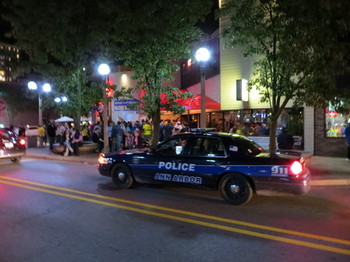Ann Arbor's a pretty safe place. Although it sometimes might not seem like it, crime in the city for the most part remains near historic lows, with yet another drop in violent crimes recorded last year.
That's at least partly due to the job done by the Ann Arbor Police Department, which has remained effective despite budget cutbacks in recent years. However, Police Chief John Seto has publicly said the department could do better—take a more proactive approach—with more staff.

Police patrol South University Ave within the Ann Arbor DDA Zone.
Seto spoke out on the issue last month, saying that the department does a good job of reacting to crime. But, he argued, proactive efforts like increased downtown foot patrols and more community outreach could help make a strong community even stronger. He also mentioned the concept of a cross-jurisdiction "crime strategy unit," which shows intriguing potential. Overall, his points made a lot of sense.
The difficulty, of course, is that they would require more staff to implement. And the city's budget has been tight in recent years.
During last month's budget deliberations, the council considered—and ultimately rejected, 6-5—a push to add three full-time employees to the police department. The problem was that the change would have been funded by cutting the 15th District Court budget, likely leading to the loss of half of the court's six probation officers.
That would have been a pretty extreme trade-off, but the fact that it found five votes in favor shows how seriously council members are taking this. At that meeting, Mayor John Hieftje suggested the Downtown Development Authority might be able to fund three police officers dedicated to the city's core. And earlier this month the council made that a formal request, asking the DDA board to pay for three beat cops.
Of course, it's always a good idea to have a bit of built-in skepticism when any government agency makes a plea for more staffing. In this case, however, the benefits are clear—more police downtown would likely improve the department's ability to be proactive and the public's perception of downtown safety.
In approaching the DDA, the council found a good way to start addressing an an important concern. Here's hoping that the DDA agrees, and that the council continues to work on ways to strengthen public safety.